Brief history of Starry Stonewort on Clearwater
Below is a brief summary from the date we discovered Starry Stonewort along with updates as we've received them. Scroll to the bottom for the first report and then scroll up to read the reports as they were published. A short description of the plant plus images to aid in identification are shown at the bottom of this page.
Aug. 19, 2025:
Starry Stonewort dive survey findings. We have continued our program to address the aquatic invasive species, Starry Stonewort, since it was discovered in Clearwater Lake two years ago. On a schedule, divers survey the infested area in addition to the regular survey of the entire lake. On August 19th divers found a new small area of Starry in the back bay 1.27 acres in area, and the divers found a slight expansion of the existing treatment area up to 5.67 acres. In total, we are now treating 6.94 acres. We have discussed treatment plans with our treatment applicator, Lake Restoration, and they have submitted new documentation (shapefiles) to the DNR. Assuming a rapid permit response, their plan is to treat on Monday. It's critical in our efforts to control and try to eliminate Starry Stonewort that people stay out of and clear of this area. We understand that this is a popular fishing area for many, but we all need to do our part and stay out of this area with a good margin even from the buoys. We have not been successful in persuading everyone from staying away from this area. If you see anyone fishing in this area including inside the buoys, please ask them respectfully to leave the area. We cannot mandate, but we can nicely ask. Please spread the word to your friends and neighbors. Thank you!!
.jpg)
Aug. 19, 2024
We are halfway through the starry stonewort (SSW) growing season which goes from July through September. There have been 2 treatments to the infested area with one on July 26th and the other August 9th. A survey dive on August 15th found 2 areas of moderate growth. Fortunately, nothing was found outside the containment area. This last dive was a great improvement over what was found during the survey dive in July when 4.4 acres of SSW was found. At the time, there were mats up to 3 feet thick, coming within inches of breaking the water surface. There have been 2 dives at the 7 boat ramps and no SSW found. There will be one more dive in late September/early October. A point intercept survey was done of the entire lake on August 15th & 16th. To date, no more SSW has been found. Recall, it was the point intercept survey of August 21st, 2023 that discovered SSW in Clearwater Lake. The plan is for a third SSW treatment the end of August, followed by a survey dive around September 13th. A fourth and final treatment will likely be in late September. It is typical to treat up to 4 times in the first 1-2 years following discovery with the frequency dropping to 2 or 3 times yearly thereafter. Even with the compressed time frame following discovery in late August last year, we were able to do 3 treatments. There you have it. Another update and season review will be in the Fall newsletter coming out in late October/early November.
July 19, 2024
To the Clearwater Lake Property Owners,
The month of July is typically the start of growing season for starry stonewort (SSW) which will continue into early December. Surveillance for SSW is timed to the obseerved growth happening in Lake Kroronis and its heavy infestation. Steve McComas of Blue Water Science conducted survey dives at Clearwater lake's seven boat ramps and our own SSW infested site on July 18th.
The good news is that no growth was found at any of the boat ramps. The bad news is for a relatively heavy growth of SSW in our previously treated area. Though the infested area continues to be contained within the small bay rung by a dense growth of bullrushes, the shape profile for treatment has grown to 4.4 acres from an initial 1.85 acres & 3.15 acres last year. The application for a DNR premit to treat is in process. Lake Restoration, our treatment contractor, anticipates treatment in the water by mid-week of July 22nd. There will be a repeat dive for effect in 10 days generating, in alllikelihood, another shape file for more treatment.
We will offer updates while continuing our aggressive plan of management.
Your CLPO
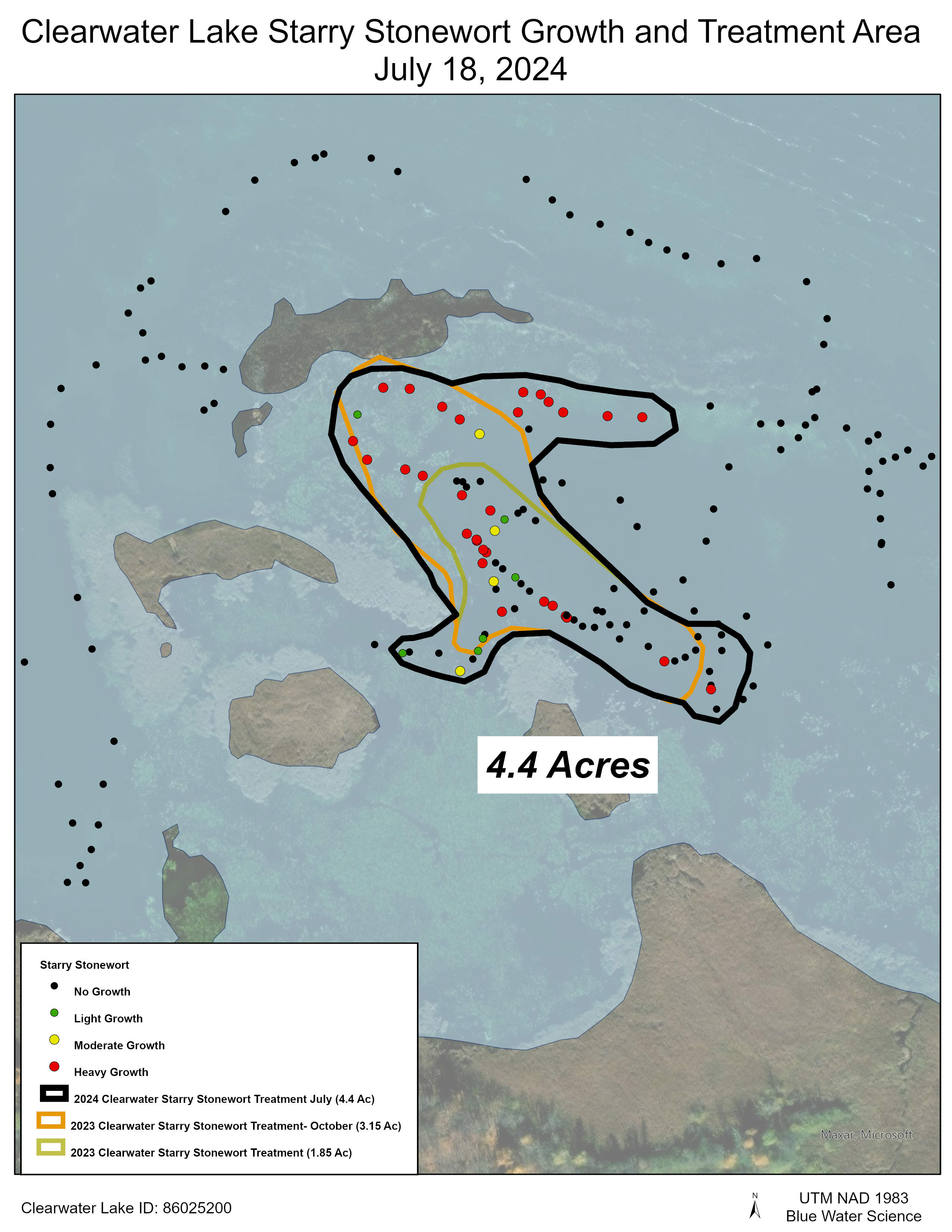
September 5, 2023
Hello Everyone,
I hope everyone had an eventful and safe Labor Day holiday weekend. I wanted to take a moment to offer an update on where we stand in the management of the newly discovered Starry Stonewort (SS).
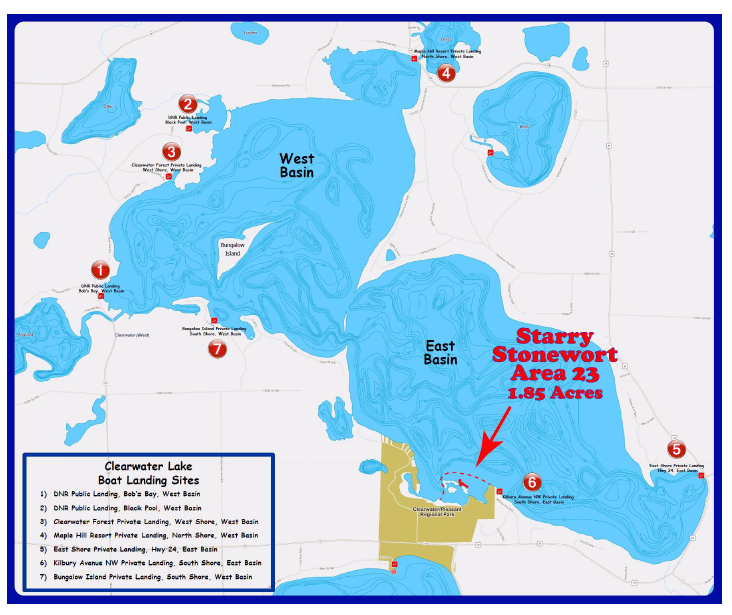 The discovery of SS in Clearwater Lake happened during a scheduled point intercept survey of lake vegetation by our contractor, Blue Water Science, on August 21st. I’d like to give a timeline, perhaps benefiting all of us, on how our treatment response has been unfolding:
The discovery of SS in Clearwater Lake happened during a scheduled point intercept survey of lake vegetation by our contractor, Blue Water Science, on August 21st. I’d like to give a timeline, perhaps benefiting all of us, on how our treatment response has been unfolding:
1. Late night August 21st: Bluewater Science contacted me with the discovery of SS in Clearwater Lake, East Basin, south shore bay. The area is the water inlet from Pleasant Lake known to have SS since 2018.
2. August 22nd: Notification sent to our treatment contractor Lake Restoration about the find as well as state agencies including MN DNR, Clearwater River Watershed District (CRWD), Wright Soil & Water District (WSWD) and the CLPO board.
3. August 22nd: I was notified by Blue Water Science that the point intercept survey was complete and no more SS was found in the lake.
4. August 22nd & 23rd: After CLPO board discussion, a decision is made to mark the SS infested area with signs to keep the infestation contained. We found that marking such areas is not something done by the DNR or our treating contractor.
5. August 24th: Steve McComas of Blue Water Science shares maps & shapefiles of the infested area which measures to be 1.85 acres in size at an average depth of 5 feet.
6. August 28th: The CLPO and DNR make a public announcement about the presence of SS in Clearwater Lake after verification by the DNR specialist.
7. August 29th: The CLPO board expresses concern to the watershed (CRWD) about possible SS infestation in the waterways between Pleasant Lake and Clearwater Lake.
8. August 30th: CRWD contracts with Blue Water science for surveys of the connecting waterways.
9. August 31st: 14 floating signs marking the infested area are placed in advance of the Labor Day holiday weekend.
10. September 1st: Notification from Lake Restoration that the shapefiles of the infested area for the presence of 1.8 acres of SS have been verified by the DNR and after a mandatory 48 hour wait period, treatment will begin.
11. September 5th: Notification of first treatment completed by Lake Restoration.
More information will follow as our plan for management progresses. The CLPO board has a scheduled meeting for Monday, September 18th where I will update the members and introduce for discussion & approval, (1) a dive in October by Blue Water Science to survey treatment results and (2) contract for another point intercept (PI) survey of the lake next summer. Remember the PI survey is completed every 3-years but based on our recent findings, I believe it to be well worth repeating next year.
We will continue to offer updates through the CLPO website and the upcoming fall newsletter in late October. I want to also encourage everyone to help in our efforts by maintaining your CLPO membership & encouraging those that haven’t joined to consider doing so. Times like these, I (we) need your membership support and donations.
Paul Pattee
AIS Manger
Clearwater Lake Property Owners
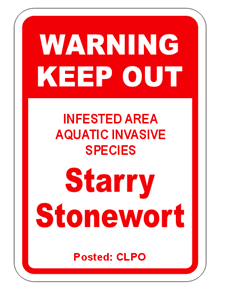 It is with disappointment I share the news that Starry Stonewort, an aquatic invasive species plant, has been found growing in Clearwater Lake. It was detected on Monday, August 21st, by Steve McComas of Blue Water Science while conducting the 2023 point intercept survey of Clearwater Lake. The survey, done every 3 years, was completed on August 22nd. No additional Starry Stonewort was found.
It is with disappointment I share the news that Starry Stonewort, an aquatic invasive species plant, has been found growing in Clearwater Lake. It was detected on Monday, August 21st, by Steve McComas of Blue Water Science while conducting the 2023 point intercept survey of Clearwater Lake. The survey, done every 3 years, was completed on August 22nd. No additional Starry Stonewort was found.
Clearwater Lake becomes the 26th lake in the state to be infested & only the second lake where it was not found at a boat landing. An estimated 1.8 acres of Starry Stonewort growth was found in an isolated bay and because of its location, went undetected for perhaps 2-3 years. If not for the point intercept survey, the infested area & threat of spread would have remained undetected and unrecognized. The area of infestation is in the East Basin and will be marked by a perimeter of signs:
2024 SSW Clearwater Search Report
2023 SSW Clearwater Search Report
2022 SSW Clearwater Search Report
2021 SSW Clearwater Search Report
2020 SSW Clearwater Search Report
Starry Stonewort Identification
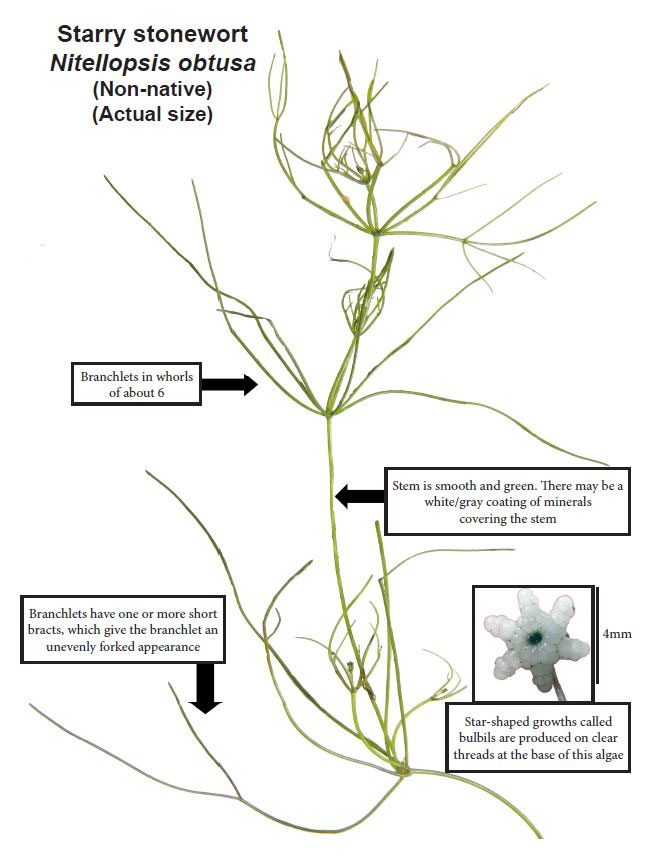
Starry stonewort is a grass-like form of algae that are not native to North America. It typically grows an inch a day in height and width. It does not go dormant and continues to grow in the winter-time. You can't swim, fish or boat in it and it is poisonous to animals. To date, no lake has been able to eradicate it, which is why they call it a "lake killer".
The plant was first confirmed in Minnesota in Lake Koronis (Stearns County) in late August of 2015. Plant fragments were probably brought into the state on a trailered watercraft from infested waters in another state.
Other lakes in MN have since discovered Starry Stonewort, with one of them being Lake Sylvia, Rice Lake and Grand Lake. So, we now have four lakes very close to us that are now infected with Starry Stonewort: Lake Sylvia, Rice Lake, Grand Lake & Lake Koronis.
How to identify Starry Stonewort
Starry Stonewort is similar in appearance to native grass-like algae such as other stoneworts and musk-grass, which are commonly found in MN waters. Starry Stonewort can be distinguished from other grass-like algae by the presence of star-shaped bulbils.
Starry Stonewort Fact Sheet
Follow this link to view a brief but excellent description of the differences between Starry Stonewort and some of our native species.
Useful Video to Identify Starry Stonewort
Here's another great video from YouTube on identifying Starry Stonewort.
Chara looks a lot like Starry Stonewort. Click Here for a fact sheet on how to compare the two.
** If you suspect you have found Starry Stonewort or any other invasive species, note the exact location, don't disturb the area, take a photo or keep the specimen and contact the DNR & CLPO. Early detection is key!!!
Why is Starry Stonewort a problem?
Starry Stonewort can interfere with recreational and other uses of the lake by producing dense mats at the waters surface. Boats are not able to get through these dense mats. It may displace native aquatic plants and choke out fish spawning beds.
How does it spread?
Starry Stonewort is believed to be spread from one body of water to another by unintentional transfer of plant fragments and bulbils, the star-like structures produced by the plant. The fragments, or mud containing the fragments, can be transferred on trailered boats, personal watercraft, docks, boat lifts, anchors or any other water-related equipment that has not been properly cleaned.
What can people do to prevent its spread?
The most important action you can do to prevent the spread of Starry Stonewort is to Clean, Drain, Dispose, which is required by law in MN.
Clean all vegetation, animals, mud & debris from your watercraft and any water-related equipment before moving it from one body of water to another.
Drain all water from your watercraft and bait bucket(s), including lowering the lower unit once you're out of the water to allow the water to drain before installing the transom saver bar and keep the drain plugs out during transport.
Dispose of any unwanted bait in the trash.
Right now there are no laws limiting access to Starry Stonewort infected waters, but keeping water related equipment out of the infected lakes right now while they are trying to find a treatment would be the safest.
What can be done to reduce Starry Stonewort?
Starry stonewort is an algae, not a herb, and consequently algaecides, not herbicides have shown to be effective. In small areas hand pulling combined with algaecides has proven to be the most effective treatment, and for newly discovered infestations immediate treatment can be nearly complete. Mechanical harvesting creates fragments that amplify the spread of the invasive plant within the lake and is generally not recommended.
Clearwater Lake - Starry Stonewort Early Detection Search
Unfortunately on Monday, August 21, 2023, Starry Stonewort has been found growing in Clearwater Lake by Steve McComas of Blue Water Science while conducting our 2023 point intercept survey.
Clearwater Lake becomes the 26th lake in the state to be infested and only the second lake where it was not found by a boat landing. An estimated 1.8 acres of Starry Stonewort growth was found in an isolated bay and because of its location, went undetected for perphaps 2-3 years. Thankfully the point intercept survey found it. The area of infestation is in the East Basin and will be marked by a perimeter of signs with red lights. They will have to be taken out before winter & put back in the spring. It's EXTREMELY important that everyone stays far away from that area.
 Multiple chemical treatments were conducted in 2023 and 2024 and were followed by ongoing assessments. Given the size of the area of growth, hand pulling is not practical and more aggressive harvesting with machines is not recommended because of greater risk for spread.
Multiple chemical treatments were conducted in 2023 and 2024 and were followed by ongoing assessments. Given the size of the area of growth, hand pulling is not practical and more aggressive harvesting with machines is not recommended because of greater risk for spread.
There is room for some optimism in that thhe area of growth is confined and considered, much to our benefit an early detection. Early detection has historically been the key to successful control of Starry Stonewort. The CLPO's AIS plan has been effective in its design and implementation and will continue to be aggressively applied as we move forward.
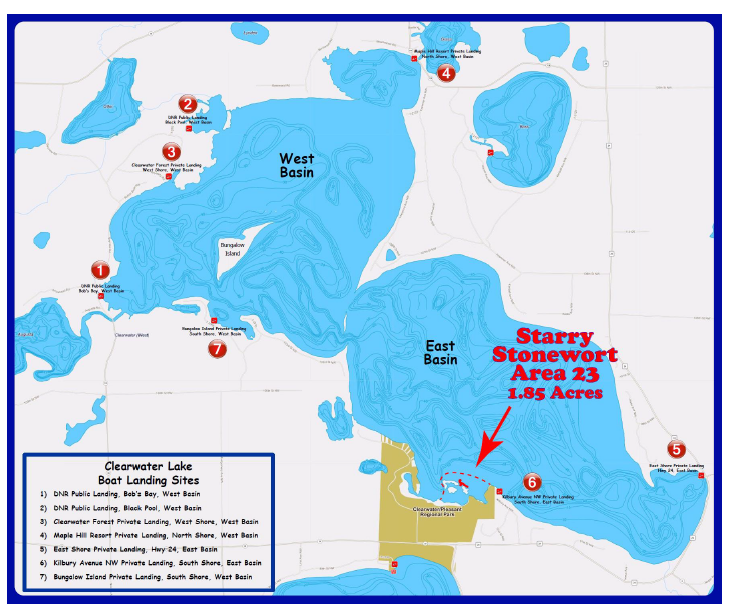
2024 Clearwater SSW Search Report
2023 Clearwater SSW Searches Report
2023 Clearwater SSW Discovery Aug. 21, 2023 Report
2023 SSW Search Sites
2022 Clearwater SSW Search Report
2021 Clearwater SSW Search Report
2020 Clearwater SSW Search Report
Early Detection Report from Jan. 2020
Early Detection Report from 4-8-17
Recent History of Starry Stonewort on Clearwater Lake
On Aug 2nd & Oct. 9th, 2017, we had Blue Water Science come out and search for Starry Stonewort at the Bob's Bay landing area, Hwy 24 and the Black Pool landing area. They did not detect any Starry Stonewort. Below are two videos they took of the underwater view.
Video 1
Video 2
SSW Search Report 8-2-17 & 10-9-17
Good news for Clearwater Lake from the Starry Trek event held on August 5th. A potential AIS sample collected near the Black Pool DNR access ramp was found to be native and not Starry Stonewort. Unfortunately for another lake in our region the news was not so good. A sample collected from Grand Lake was confirmed to be Starry Stonewort, thus adding yet another Minnesota lake to the infested category. This is a good reminder that we all need to be vigilant - when we move boats (and docks) from lake to lake we need to ensure that we Clean, Drain, and Dry our boats and trailers. This isn’t just a slogan on a sign, it’s what we need to do every time.
Please watch the AIS Video below, which shows how fast and destructive it is to a lake.
AIS Video - Above and Below the Waterline
Background Information on Starry Stonewort Control Efforts
How to write your legislature to help stop the spread of Starry Stonewort
Powerpoint Presentation from the WI DNR
6-5-19 Progress in Controlling Starry Stonewort
4-22-17 Starry Stonewort Summit Summary
4-22-17 Starry Stonewort Summit Presentation - Dr. Rodgers
Additional info from the Univ of MN
Starry Stonewort Watch Card



.jpg)

 The discovery of SS in Clearwater Lake happened during a scheduled point intercept survey of lake vegetation by our contractor, Blue Water Science, on August 21st. I’d like to give a timeline, perhaps benefiting all of us, on how our treatment response has been unfolding:
The discovery of SS in Clearwater Lake happened during a scheduled point intercept survey of lake vegetation by our contractor, Blue Water Science, on August 21st. I’d like to give a timeline, perhaps benefiting all of us, on how our treatment response has been unfolding: It is with disappointment I share the news that Starry Stonewort, an aquatic invasive species plant, has been found growing in Clearwater Lake. It was detected on Monday, August 21st, by Steve McComas of Blue Water Science while conducting the 2023 point intercept survey of Clearwater Lake. The survey, done every 3 years, was completed on August 22nd. No additional Starry Stonewort was found.
It is with disappointment I share the news that Starry Stonewort, an aquatic invasive species plant, has been found growing in Clearwater Lake. It was detected on Monday, August 21st, by Steve McComas of Blue Water Science while conducting the 2023 point intercept survey of Clearwater Lake. The survey, done every 3 years, was completed on August 22nd. No additional Starry Stonewort was found.
 Multiple chemical treatments were conducted in 2023 and 2024 and were followed by ongoing assessments. Given the size of the area of growth, hand pulling is not practical and more aggressive harvesting with machines is not recommended because of greater risk for spread.
Multiple chemical treatments were conducted in 2023 and 2024 and were followed by ongoing assessments. Given the size of the area of growth, hand pulling is not practical and more aggressive harvesting with machines is not recommended because of greater risk for spread. 
.jpg)
.jpg)
.jpg)
.jpg)

.jpg)
